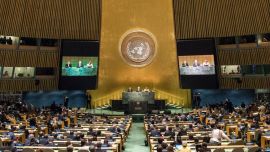Carnival would seem a propitious moment for the pay talks at national level with everybody in a good mood for reaching consensus – even such militant union warhorses as Roberto Baradel (“You don’t need conflict when you have a government which listens”) and Hugo Yasky (a sudden convert to the idea that index-linking salaries is bad because it projects past inflation into the future) are magically all sweetness and light these days, disavowing any strike action.
Yet the sacrifice of index-linking means that peace is only assured until midyear, not the entire 2020 calendar – the teacher pay floor is be raised nationwide to 23,000 pesos from the current 20,250, and 25,000 from midyear, supplemented by a monthly incentive bonus of 1,210 pesos between March and June. The increase is thus an initial 13 percent and 23.5 percent by midyear with all included – pay restraint indeed in the light of last year’s 53 percent inflation. It remains to be seen if the new minimum wage expected in April affects pay (since the salary floor for teachers must be at least 20 percent above the minimum wage according to a law of the Mauricio Macri administration) or whether that law decreed as a substitute for suspending national collective bargaining now falls into disuse with the return of the latter.
This new nationwide pay floor needs to address deep provincial disparities, given that education (along with health) has been decentralised since 1991-1992. Not even the start of classes is uniform – this coming Monday almost everywhere but last Wednesday in Mendoza (and also strife-ridden Chubut but delayed by a strike) and March 9 in torrid Misiones. The disparities are even greater when it comes to pay with some provinces well above both past and future floors and others far below – thus teachers in Córdoba, San Luis and some Patagonian provinces (on either side of the 30,000-peso mark last year) double their poorer northern colleagues, for whom a hike to 23,000 pesos (guaranteed by the national government) would approximate last year’s inflation. The general thrust of incomes policy to replace percentages with lump sums might well end up evening this balance.
As usual, one province hogs the attention. Union moderation is gratefully welcomed by Buenos Aires Province Governor Axel Kicillof, who has opined more than once that it is high time teacher salaries ceased to be the obsessive focus of the educational debate in favour of other aspects such as updating school infrastructure. Kicillof has a point but this is also a philosophy of convenience since the most urgent school repairs would only cost a fraction of the billion-plus pesos which just honouring the index-linking clause in the previous collective bargaining agreement would have set back provincial coffers (postponed by the former economy minister from last to next month without any hard feelings from teacher unions). Kicillof’s offer is a lump sum (initially 3,000 pesos and then upped to 4,000) to the entire provincial payroll of some 850,000 employees, of whom teachers number around 45 percent. This would give most teachers 15 to 20 percent, again well behind last year’s inflation – it remains to be seen whether this would buy time and peace for the first half of 2020 or whether it sparks friction, not so much from the tame unions (although FIT leftist deputy Romina Del Plá is also a unionist in La Matanza) as the teachers themselves.
Why do lowly pay levels so belie the middleclass social status of teachers? Many reasons but a key one is hardly ever mentioned – their sheer number of some 1.2 million (or one for every 37 Argentines of all ages, not far above the average classroom size). By comparison the United States with over seven times Argentina’s population has only three times as many teachers. Why so many? Again many reasons, but successive overlaps of supply teachers becoming permanent might bulk large. The female gender and the public sector typify a dominant majority of teachers – 80 and 71 percent respectively – and many of these women (their maternal instincts perhaps aroused by the constant presence of children) take maternity leave at some point with their substitutes often becoming part of the system.
But Kicillof still has a point – teacher pay should not monopolise the educational agenda. Quality should be more central with attention often drawn to Argentina’s substandard PISA (Programme for International Student Assessment) performances. Then there is the future of university education – free education and unrestricted admission are noble principles but their track record over more than a century has provided gratuitous subsidies for middle-class mediocrity (increasingly from beyond national borders) rather than upward social mobility for the children of workers. Not to mention overcrowded universities – the University of Buenos Aires (UBA) alone has over 308,000 students, which makes for the Federal Capital having a higher percentage than such purely university cities as Cambridge, England.
The problems of education could fill this page and more but this column supposedly studies the Education Ministry and its minister.
Nicolás Alfredo Trotta is not the baby of this Cabinet (some of its most important members, such as Economy Minister Martín Guzmán and Cabinet Chief Santiago Cafiero, stand in his way) but at 44 he is definitely among the youngest. His main credentials for the post are having been chancellor of UMET (Metropolitan University for Education and Work) since 2014, along with frequent television appearances, specialising in political interviews across the region (including Brazil’s former leader Luiz Inácio Lula da Silva and ex-Bolivian president Eva Morales – and also Alberto Fernández).
The Education Ministry first started life as such in 1949 although it had been half a ministry at least since the very first formal Cabinet in 1854 (the Ministry of Justice and Public Instruction). Until the presidency of Domingo Faustino Sarmiento (1868-1874 when up to 82 percent of the population was illiterate) nobody attached much importance to education and illiteracy was still measured at 35.9 percent in the 1914 census (over half in 10 provinces).
Education was reunited with Justice in the 1956-1966 and 1983-1989 periods as the superior half of the ministry this time. Both Science and Culture were previously within the orbit of the ministry (although the latter often directly under the presidency) until removed in 2007 and 2014 respectively.
There have been 42 ministers since 1949. One of the best was Daniel Filmus (2003-2007), strangely ignored for the post since then, including now.
And so the school year begins.related news





















Comments